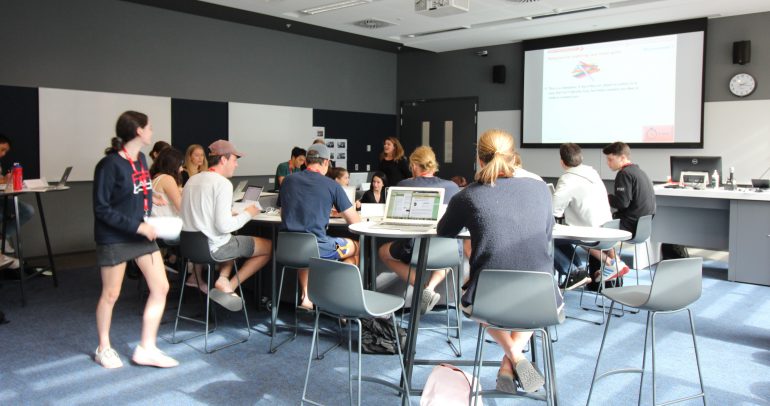Recently I found myself looking for a good way to kick-off a meeting about physical learning spaces, in Zoom. The irony of allocating time online to focus on the planning of physical infrastructure for learning during a pandemic that requires us to maintain our distance, was not lost on me. But we had set aside an hour to assess where we were and consider next steps, and I wanted to acknowledge the current context without derailing what had been planned, entirely.
We are in the process of changing the way we allocate learning space, at the University of Sydney. Currently, what we do can best be described as room booking and it involves academics nominating a preferred room and time of day, and timetabling staff doing their best to accommodate these requests. This practice is unsustainable at scale, not to mention challenging in terms of satisfactorily accommodating the learning and teaching needs of all in any given semester. The new system will shift the focus from the preferences of individual educators (time, location, and anticipated enrolments), to the collective needs of educators and learners by location or zone (frequency, learning requirements, and anticipated enrolments). Key to making this a positive change will be our ability to define learning requirements—with respect to physical attributes of space for learning.
Our challenge, in this meeting, was to begin the process of identifying physical attributes of space that support valued teaching and learning practices. I thought a general question about what we miss in the current context would provide a good lead in.
So, what do you miss the most?
I miss the gaps between things. The time/space pauses between one meeting and the next. I hadn’t realised how much I relied on these moments to process thoughts from one conversation, before diving headlong into another. I hadn’t really appreciated the physicality of these gaps—the role of the material in accommodating and defining the quality of these gaps. Looking at old manuscripts carefully laid out by librarians as I walked the length of Level two in Fisher library on my way to grab a coffee or take a bio-break, or taking a slightly longer route across campus to catch a glimpse of new leaves, walk through old leaves, or check for new artwork in the graffiti tunnel.
Colleagues quickly filled in my yearning for physical space with talk about absent people: corridor catchups, serendipitous meetings, and the comforting routines of shared breaks over a coffee or meal. Having remembered our not so distant physical past it wasn’t long before we were talking about the challenges of meeting in virtual space. It’s not that we were not appreciative of the relative ease with which we seemed to be carrying on. Rather, as we talked, the (learning spaces) researcher in me noticed how we were cataloguing attributes of virtual space that did not support qualities of human interaction that we value—following a gaze to establish shared meaning, anticipating the contribution of another, or sharing a momentary visual acknowledgement before instigating a shift in topic. All of which are amplified in the online spaces in which our students are currently learning. But as we shifted from personal expressions of (temporarily) lost community and (tentative) celebrations of new forms of online connection, to future plans for place-based learning, we stalled. What would the future hold, what does a physically distant campus even look like, and how will we honour our duty of care to both our students and our staff?
Where to next?
None of us knows what changes the next six months will bring, let alone the next five years. However, when it comes to the planning of physical infrastructure for learning, time frames are necessarily long and the consequences of failing to consider how the physical properties of learning space will influence future teaching and learning practice are real. Sometimes I think we should talk about the concrete curriculum, the material instantiation of current learning and teaching policy. Noting that whilst policy may sometimes appear to struggle to keep up with changing contexts, it is far more flexible in terms of renewal than the ‘concrete curriculum’.
In preparing for the future, it is safe to say that our current experiences of learning and teaching will develop in us a far more nuanced appreciation for what is possible, and what is desirable, both in terms of physical and digital spaces for learning. And we would do well to make decisions that honour our duty of care with respect to health and learning, diversity and access, and human connection.
How can you help?
During June and July I will be running Zoom workshops with academics from across disciplines to identify and prioritise a list of learning space requirements. For example, someone leading a workshop or studio may prioritise a learning space that supports time together and time apart. I would refer to this as a need for alternating points of visual attention. Others may have less need for a single point of shared visual attention and may prioritise a learning space that supports distributed group attention (i.e. team or case-based learning) or individual attention (i.e. computer labs).
Your help in articulating what it is about particular learning spaces that you value, would be much appreciated. Accommodating the learning of more than 70,000 students in more than 1,000 learning spaces will always be challenging but your participation in calibrating the system that will help us do this well—will be time well spent.
To register for a 1 hour Zoom workshop
- Weekdays in June and July,
- at a time that is convenient for you and/or your team,
- focusing on general teaching spaces (lecture theatres, seminar rooms, collaborative learning studios, and computer labs),
- please email [email protected].





